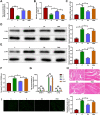Adiponectin reduces apoptosis of diabetic cardiomyocytes by regulating miR-711/TLR4 axis
- PMID: 36114541
- PMCID: PMC9479314
- DOI: 10.1186/s13098-022-00904-y
Adiponectin reduces apoptosis of diabetic cardiomyocytes by regulating miR-711/TLR4 axis
Abstract
Objective: To investigate the regulation of adiponectin/miR-711 on TLR4/NF-κB-mediated inflammatory response and diabetic cardiomyocyte apoptosis.
Methods: Diabetes models were established using rats and H9c2 cardiomyocytes. qRT-PCR was used to detect adiponectin, miR-711, and TLR4. MTT, β-galactosidase staining, and flow cytometry were utilized to assess cell viability, senescence, and apoptosis, respectively. The colorimetric method was used to measure caspase-3 activity, DCFH-DA probes to detect ROS, and western blotting to determine the protein levels of Bax, Bcl-2, TLR4, and p-NF-κB p65. ELISA was performed to measure the levels of adiponectin, ICAM-1, MCP-1, and IL-1β. Dual-luciferase reporter system examined the targeting relationship between miR-711 and TLR4. H&E and TUNEL staining revealed myocardial structure and apoptosis, respectively.
Results: Adiponectin and miR-711 were underexpressed and TLR4/NF-κB signaling pathway was activated in high glucose-treated H9c2 cells. High glucose treatment reduced viability, provoked inflammatory response, and accelerated senescence and apoptosis in H9c2 cells. miR-711 could bind TLR4 mRNA and inactivate TLR4/NF-κB signaling. Adiponectin treatment increased miR-711 expression and blocked TLR4/NF-κB signaling. Adiponectin/miR-711 reduced myocardial inflammation and apoptosis in diabetic rats.
Conclusion: Adiponectin inhibits inflammation and alleviates high glucose-induced cardiomyocyte apoptosis by blocking TLR4/NF-κB signaling pathway through miR-711.
Keywords: Adiponectin; Apoptosis; Cardiomyocyte; Diabetes; TLR4; miRNA-711.
© 2022. The Author(s).
Conflict of interest statement
The authors declare there is no conflict of interest regarding this study.
Figures






References
Grants and funding
LinkOut - more resources
Full Text Sources
Research Materials
Miscellaneous

